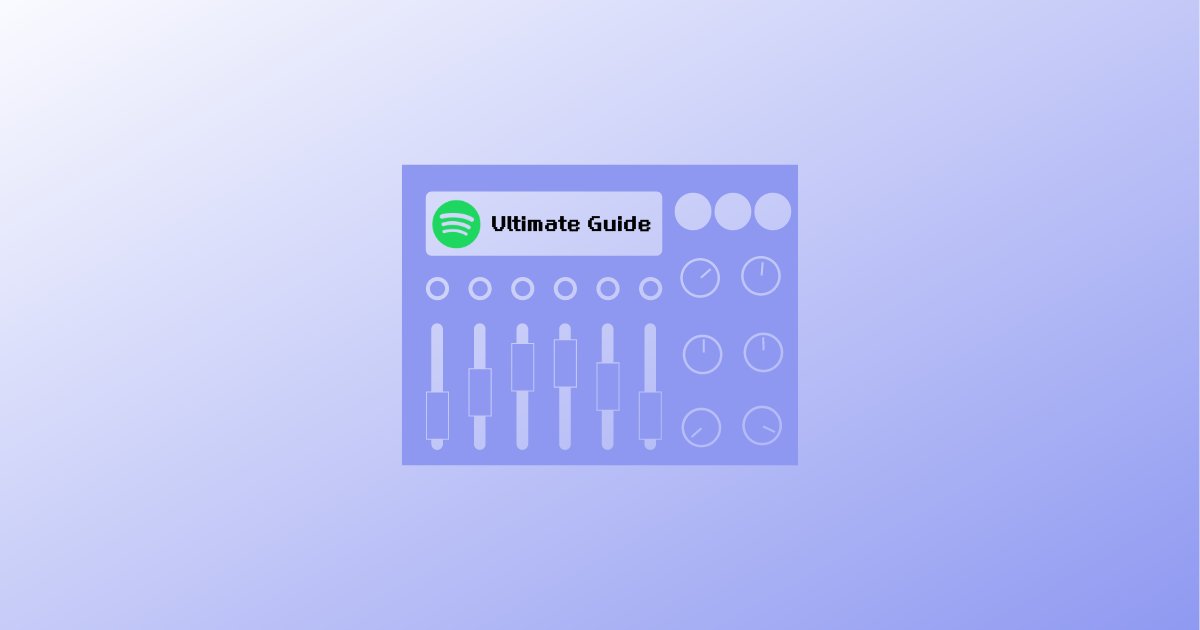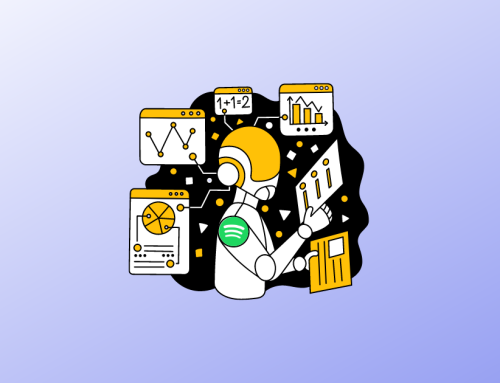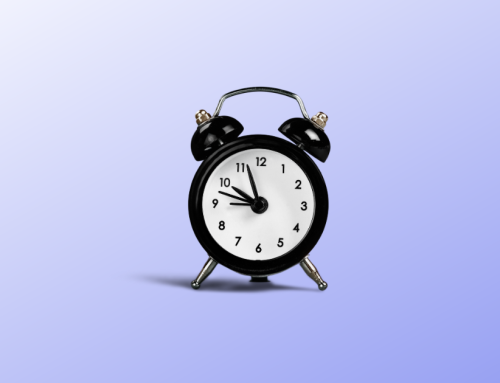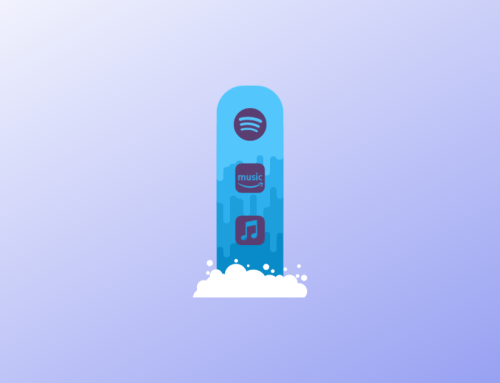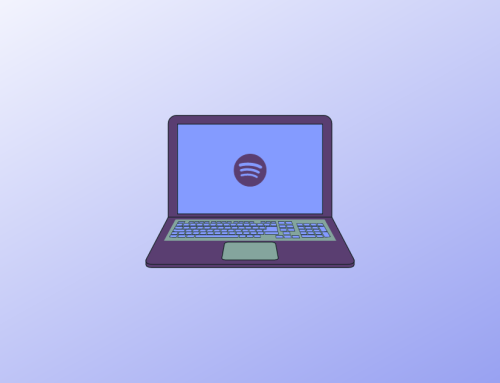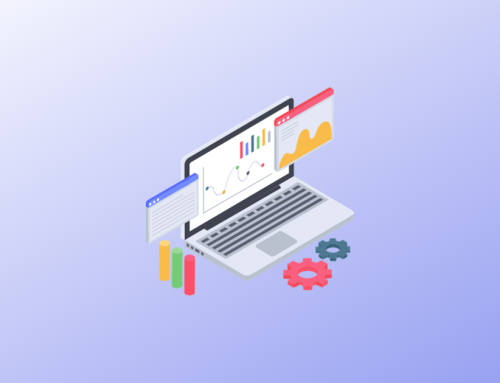Understanding Spotify’s intricate ecosystem is crucial for record labels aiming to maximize their artists’ visibility and engagement. With millions of tracks and fierce competition, standing out requires strategy, insight, and a bit of creativity. Whether you’re looking to boost streams, enhance artist profiles, or tap into Spotify’s powerful promotional tools, we’ve got you covered. Let’s embark on this journey together and unlock the full potential of Spotify for your label.
Using Spotify for Effective Music Distribution and Promotion
When putting your artists’ music out there and ensuring it reaches as many ears as possible, Spotify stands out as a go-to platform for record labels. Here’s how you can leverage it for effective music distribution and promotion.
Get Your Basics Right: First, ensure your music is uploaded through a reputable distributor with a good relationship with Spotify. This ensures your tracks are correctly listed and you can access Spotify for Artists. This portal lets you control your artist profiles, analyze track performance, and run promotional campaigns.
Playlist Placement: One of Spotify’s most prominent features for music promotion is its playlists. Getting a track listed can significantly boost streams and visibility. Start aiming for Spotify’s curated playlists by submitting unreleased music via Spotify for Artists. Don’t overlook user-generated and third-party playlists; connect with curators through social media and networking events.
Here’s a breakdown of playlist types:
- Spotify’s Curated Playlists: Managed by Spotify’s editorial team.
- Algorithmic Playlists: Like Discover Weekly, personalized for each listener.
- User-Generated Playlists: Created by Spotify users.
Use Spotify Ad Studio: Record labels can use Spotify’s Ad Studio to run targeted audio and visual ads. These ads can introduce your artists to potential fans through their favorite songs, making them a strategic way to increase awareness and streams.
Leverage Spotify Codes: Think of Spotify Codes as social media hashtags but for music. Place them on marketing materials, social posts, or even merchandise. It’s a quick scan away for someone to discover and stream your artist’s music.
Release Radar & Discover Weekly: Ensure your tracks are released strategically to maximize the chance of appearing in these algorithm-driven playlists. Release Radar is updated every Friday with new releases, whereas Discover Weekly adapts according to the listener’s music taste. Engaging your existing fan base to stream upon release can amplify your chances of getting picked up by Spotify’s algorithm.
Remember, consistently releasing music helps keep your audience engaged while increasing the chances of your tracks being featured across Spotify’s vast listening ecosystem. Track what works best for your music genre and artist’s style, adapting your strategy as you learn what resonates with your audience.
Understanding Spotify’s Impact on the Music Industry
Spotify has rewritten the rules of engagement between music and listeners. As a record label owner, comprehending this platform’s trajectory and vast influence is pivotal. Let’s dig deep into Spotify’s evolution and global outreach to pinpoint how it can scale your artists and tracks to new heights.
The Evolution of Spotify
When Spotify hit the scene in 2008, it started as a ripple but swiftly turned into a tidal wave, altering how people access and enjoy music. Initially, it distinguished itself with a user-friendly interface and an expansive music library, offering a legal streaming alternative in a landscape riddled with piracy. Fast forward, and it’s clear that Spotify isn’t just another player in the game; it’s the field for many fans and artists alike.
Key Developments:
- Introduction of Spotify for Artists: This tool returned power to the creators, letting you and your artists jump into listener demographics, track performance, and manage profiles. It’s a goldmine for tailoring marketing strategies and understanding your audience.
- Spotify’s Algorithmic Playlists, Discover Weekly, Release Radar, and Daily Mix, have become the new radio DJs, introducing listeners to new tracks based on their listening habits. For labels, getting your artists featured can dramatically spike streams and visibility.
- Podcast and Video Integration: Reflecting broader entertainment consumption trends, Spotify’s expansion into podcasts and, to a lesser extent, videos underscores its ambition to be an all-encompassing media hub, opening more avenues for artist promotion.
Understanding Spotify’s evolution will equip you to navigate its ecosystem and leverage these developments to your label’s advantage.
Spotify’s Global Reach and Influence
Spotify’s tapestry weaves through 178 countries, making it a behemoth in global music distribution. Its outreach is vast and profoundly influential in shaping worldwide music trends and consumption behaviors.
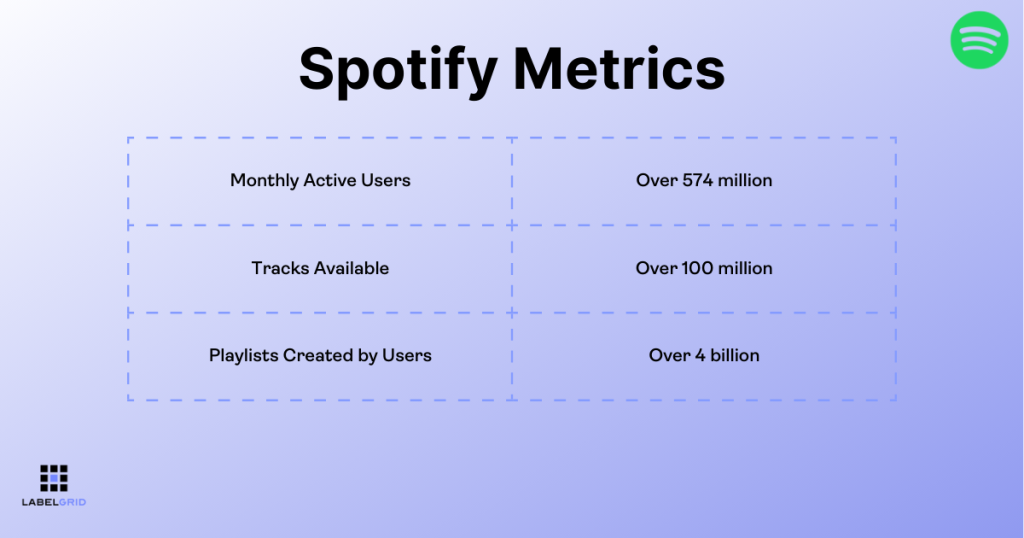
This immense reach introduces a unique advantage for labels: ubiquity. Your artists’ music can cross borders without the traditional logistical and financial barriers of physical or digital distribution. Also, Spotify’s data analytics afford insights into markets you might not have considered, guiding international promotion efforts.
- Localized Content: Tailoring releases or even creating exclusive tracks for specific markets can resonate well, tapping into regional tastes.
- Cross-Market Collaboration: Encouraging or facilitating collaborations between your artists and local talents can organically expand their listener base.
Spotify for Record Labels: A Comprehensive Platform Guide
As a record label owner, you’ve likely seen how streaming platforms, particularly Spotify, have transformed the music landscape. Understanding this digital terrain can seem daunting, but understanding Spotify’s ins and outs can significantly boost your artists’ visibility and success. Let’s jump into what makes Spotify a game-changer for record labels like yours.
Key Features of Spotify
Spotify isn’t just about streaming music. It’s a multifaceted platform offering various features tailored to artists, listeners, and records. Notably’s a quick rundown of what’s on the table:
- Algorithmic Playlists are the bread and butter for many artists’ discovery on Spotify. Your artist could land on playlists like Discover Weekly or Release Radar, putting their tracks in front of potential new fans.
- Spotify for Artists: This tool is crucial for analyzing tracks’ performance data, understanding listener demographics, and even setting up artist profiles. It’s a goldmine for making informed decisions on promotion and marketing strategies.
- Spotify Ad Studio: Want to take promotions up a notch? Spotify’s Ad Studio lets you create audio ads that can reach your target audience while they’re engaged in listening.
These features help you leverage Spotify’s massive user base, ensuring your artists get the exposure they deserve.
Spotify’s Tools and Features for Record Labels
Let’s get more specific about how record labels can make the most of Spotify:
- Tailored Marketing: With Spotify for Artists, you can access invaluable data about your audience. This means you can tailor your marketing efforts to resonate with your artists’ fanbases, from the music itself to merchandising.
- Collaboration Opportunities: Spotify’s ecosystem encourages collaboration. Whether through playlist placements or co-releases with other artists on the platform, there’s ample opportunity to expand your reach.
- Cross-Market Promotion: Spotify’s global reach means you can easily break your artists into new markets. You can strategically introduce your music to listeners worldwide with tailored playlists for different regions and cultures.
Learning these tools and features effectively can significantly impact your artists’ success on Spotify. The key is continually analyzing performance data, adapting your strategies accordingly, and always looking for new opportunities within the platform. Spotify’s ever-evolving nature means there’s always something new to explore, be it emerging trends or innovative features designed to enhance music distribution and promotion.
How to Distribute Your Artists’ Music on Spotify
Steps to Distributing Music
First, to get your artists’ music on Spotify, you’ll need to work with a digital distributor, and one great option is LabelGrid. Why LabelGrid, you ask? It’s tailored for record labels, making the process streamlined and efficient. Here’s a quick breakdown:
- Sign Up: Register your label with LabelGrid. It’s a straightforward process.
- Upload Music: Next, you’ll upload your artists’ tracks. Ensure you have all the rights clearances in place—it’s crucial.
- Metadata Matters: Input accurate metadata (artist names, track titles, etc.). This step is critical for discoverability.
- Choose Spotify: When you distribute, select Spotify among the platforms. You can also choose others if you want a wider reach.
- Release Date: Set a release date. Giving yourself a buffer before the release ensures you have time for promotion.
Troubleshooting Distribution Issues
Ran into a snag? It happens. Here are a few common issues and fixes:
- Metadata Errors: Double-check metadata if tracks aren’t appearing as expected. A simple typo can throw things off.
- Rights Management: If there’s a claim against your music, ensure you have all necessary licenses and clearances. Documentation is key.
- Timing: Uploading too close to your release date can lead to delays. Always plan.
- Communication is Key: When in doubt, contact LabelGrid’s support team. They’re there to help and can guide you through any hurdles.
Getting your music on Spotify opens up opportunities for your artists. With LabelGrid and a bit of careful planning, you’re well on your way to enhancing your artists’ online presence and reaching listeners worldwide.
Mastering Spotify for Artists: Boosting Your Artists’ Presence
Spotify’s ecosystem isn’t just about distributing your music; it’s about making your artists stand out. This section explores vital strategies to amplify your artists’ presence on Spotify.
Profile Optimization Strategies
First things first, optimizing your artist’s profile on Spotify is crucial. Think of it as your artist’s resume – it must impress at first glance. Here’s how you can make that happen:
- High-Quality Images: Your artist’s profile picture and banner should be eye-catching and high-resolution. It’s the first thing listeners see, so make it count.
- Engaging Bio: Write a compelling bio that tells your artist’s story. Include achievements, influences, and anything else that can connect with listeners on a personal level.
- Regular Updates: Keep the profile fresh with the latest releases, announcements, and concert dates. Stale information won’t do your artist any favors.
- Verified Profile: MGetthat blue check next to your artist’s name. It adds legitimacy and trustworthiness.
Each of these elements plays a role in attracting and retaining listener interest.
Utilizing Spotify’s Promotional Features
Spotify offers many promotional tools designed to boost your artists’ visibility. Leveraging these features effectively can result in significant exposure gains.
- Spotify for Artists: This is your command center. Through it, you can submit tracks for playlist consideration, which, if selected, can skyrocket listeners. Remember, timing is key; submit weeks before your release date.
- Spotify Ad Studio: Consider dabbling in Spotify’s advertising platform. With Spotify Ad Studio, you can create audio ads that play between songs, targeting listeners based on their music tastes, location, and demographics.
- Release Radar & Discover Weekly: Spotify’s algorithms can work in your favor, pushing your tracks into users’ personalized playlists like Release Radar and Discover Weekly. The trick is to stay critical, releasing music regularly to keep the algorithm interested.
By implementing these strategies, you’re not just throwing music into the abyss; you’re conducting a well-thought-out plan to ensure your artists shine on one of the world’s biggest music platforms.
Understanding Spotify’s Payment Model for Record Labels
Breaking Down Spotify Payments
As a record label owner, it’s crucial to grasp how Spotify’s payment model operates to maximize your artists’ earnings and your label’s revenue. The platform operates on a “pro-rata” system, meaning the total royalty pool is divided by the total number of streams, and then that value is multiplied by your artists’ streams. Sounds a bit complicated? Let’s simplify it.
Spotify collects user subscription fees and advertising revenue from the free tier, forming a royalty pool. Your artists’ earnings depend on their total stream count and their share of Spotify’s overall streams. The rate per stream is not fixed; it varies monthly based on numerous factors, including the user’s country and subscription type. This variability can impact earnings, making it hard to predict monthly income from streams alone.
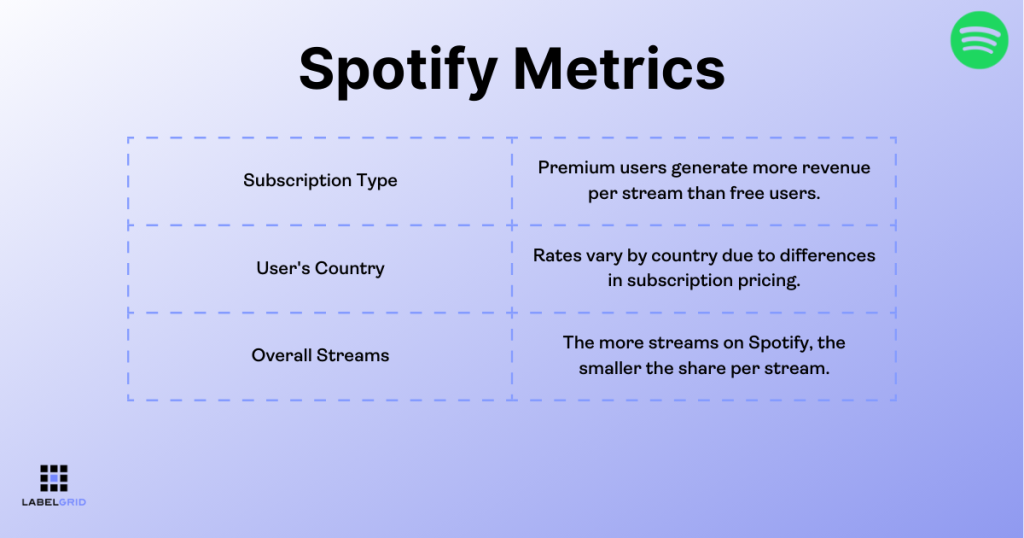
Understanding these nuances is key to strategizing effectively for your label’s presence on Spotify.
Building Sustainable Revenue Streams
Creating a sustainable revenue stream from Spotify requires more than just uploading music and waiting for streams to roll in. Here are strategies to ensure consistent earnings:
- Diversify Your Catalog: More songs mean more opportunities to get streamed. Regularly releasing new music keeps your audience engaged and helps capture a larger slice of the Spotify royalty pie.
- Encourage Fan Engagement: Active listenership boosts streams. Encourage your artists to engage with their fans through social media, Spotify playlists, and pushing content like behind-the-scenes videos or artist stories. More engagement can lead to more streams.
- Analyze and Adapt: Upotify allows artists to monitor which songs perform well and understand listener demographics. This data is golden for tailoring future releases and marketing strategies to your audience’s preferences.
- Optimize for Playlists: Getting tracks on Spotify-curated, user-created, or third-party playlists can significantly increase streams. Craft playlist-friendly tracks and use Spotify for Artists to pitch to Spotify’s editorial team.
While these strategies won’t change how Spotify pays out, they can help you optimize your earnings by increasing visibility and streams. Remember, it’s about playing smart with the cards you’re dealt to build a thriving business in the digital music landscape.
Release Strategies on Spotify for Maximum Impact
Understanding Spotify’s ecosystem effectively can turbocharge your record label’s success. Let’s break down the best release strategies on Spotify to ensure your artists make waves and your label stands out.
Planning Your Release Cycle
The first step in significantly impacting Spotify is developing a well-thought-out release plan. This isn’t just about dropping new tracks but also involves orchestrating releases to maximize visibility and engagement.
- Single First, Album Later: An effective strategy is releasing singles leading up to an album or EP. This approach keeps your audience engaged and builds anticipation for the full release. Each single can spotlight a different facet of your artist’s talent, catering to diverse listener tastes.
- Consistency is Key: Establish a regular release cycle. Whether it’s new tracks every month or an EP every quarter, consistency keeps your audience hooked and looking forward to what’s next. Spotify’s algorithm favors active profiles, so this can also improve your music’s discoverability.
- Leverage Different Types of Releases: Besides albums and singles, consider releasing remixes, acoustic versions, or live session recordings. These variations can capture the interest of a wider audience and fill the gaps between major releases.
Timing Releases for Optimal Listener Engagement
When you release, it can be just as crucial as what you release. Timing your Spotify drops strategically can amplify your reach.
- Weekdays for Attention: Fridays are traditionally popular for new releases, but consider a weekday launch to stand out. Releasing on a Tuesday or Wednesday can help you gain visibility during the mid-week content lull.
- Seasonal broader vent-Based Releases: Align releases with seasons or global events. Summer hits, holiday songs, or tracks that resonate with specific events can tap into heightened audience emotions and interests.
- Analyzing Listener Data: Use Spotify for Artists to explore when your audience is most famous. You might find that your listeners engage more during specific times of the day or week. Tailor your release schedule to these insights.
In each of these strategies, the underlying goal is to keep your audience engaged and eager for more. By carefully planning your release cycle and timing your launches for optimal engagement, your label can significantly increase its impact on Spotify. Engaging with fans through pre-saves, social media teasers, and interactive content like polls or Q&As about upcoming releases can fortify your strategy. Remember, success on Spotify doesn’t happen overnight, but with a skilled approach to planning and timing, your label and artists have everything to gain.
Marketing and Promotions on Spotify: A Guide for Record Labels
As a record label, your goal isn’t just to release music and ensure it’s heard. With its massive user base, Spotify is the perfect platform to amplify your artists’ reach. Here’s how to jump into marketing and promotions on Spotify, ensuring your music doesn’t just blend into the background.
Leveraging Spotify’s Marketing Tools
Spotify offers a treasure trove of marketing tools designed to boost your visibility. Understanding and utilizing these tools can significantly impact your promotional efforts.
- Spotify for Artists: This is your command center. From tracking real-time listening stats to updating artist profiles, it’s a must-use for labels. An up-to-date profile with engaging bios, photos, and playlist covers can attract more listeners.
- Spotify Ad Studio: Consider this your personal advertising space on Spotify. It lets you create and manage audio ads that play between songs, offering a direct way to communicate with your target audience. These ads can be tailored to reach listeners based on genre preferences, demographics, or even specific playlists.
- Marquee: A full-screen, sponsored recommendation of a new release to listeners who have shown interest in the artist. It’s like having a digital billboard on Spotify.
- Pre-Save Campaigns: You can start the hype train before your music even drops. Pre-save campaigns allow fans to add upcoming releases to their libraries, increasing the chances of an intense launch day.
Each tool serves a different purpose: building anticipation to sustaining listener engagement post-release. Mixing and matching these tools based on your specific campaign goals is the key.
Creating Engaging Promotional Campaigns on Spotify
Now that you know the tools, let’s talk strategy. Creating engaging campaigns isn’t just about blasting your audience with ads; it’s about storytelling and making meaningful connections.
- Tailored Playlists: Creating themed playlists featuring your artists alongside well-loved tracks can attract listeners looking for that perfect vibe. It’s a subtle way of introducing your artists to new ears.
- Exclusive Content: Offers something unique. This could be an acoustic version of a famous track, live recordings, or podcast featuring artists discussing their inspirations. Exclusive content can make fans feel they’re getting something special and worth sticking around for.
- Interactive Campaigns: Engage your audience by inviting them to participate in the release process. This could include voting for the subsequent single, interactive Q&A sessions with artists or fan-made cover art contests. Such interactions build excitement and foster a strong community around your label.
- Analytics: Always circle back to the data. Spotify’s detailed analytics let you see what’s working and what’s not. Use this to refine your campaigns, whether retargeting your ads or doubling down on what’s resonating with your audience.
Preparing for the Future: Spotify and Music Distribution Trends
Understanding the vast landscape of Spotify for record labels doesn’t have to be daunting. You can elevate your comeback to sense and connect with a broader audience with the right tools and strategies. By harnessing the power of Spotify for Artists, Spotify Ad Studio, Marquee, and Pre-Save Campaigns, you’ve got what it takes to create compelling promotional campaigns. Remember, it’s not just about visibility—it’s about engaging with your audience through tailored playlists, exclusive content, and interactive campaigns. And let’s not forget the importance of data. Analyzing your campaigns’ performance is crucial for refining your approach and keeping your audience hooked. As you move forward, keep these insights in mind to stay ahead in the ever-evolving world of music distribution on Spotify.
